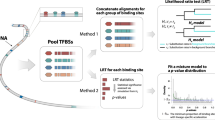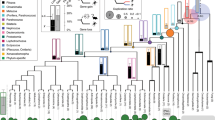Abstract
There is an emerging consensus that gene regulation evolves through changes in cis-regulatory elements1,2 and transcription factors3,4,5,6. Although it is clear how nucleotide substitutions in cis-regulatory elements affect gene expression, it is not clear how amino-acid substitutions in transcription factors influence gene regulation4,5,6,7,8,9,10. Here we show that amino-acid changes in the transcription factor CCAAT/enhancer binding protein-β (CEBPB, also known as C/EBP-β) in the stem-lineage of placental mammals changed the way it responds to cyclic AMP/protein kinase A (cAMP/PKA) signalling. By functionally analysing resurrected ancestral proteins, we identify three amino-acid substitutions in an internal regulatory domain of CEBPB that are responsible for the novel function. These amino-acid substitutions reorganize the location of key phosphorylation sites, introducing a new site and removing two ancestral sites, reversing the response of CEBPB to GSK-3β-mediated phosphorylation from repression to activation. We conclude that changing the response of transcription factors to signalling pathways can be an important mechanism of gene regulatory evolution.
This is a preview of subscription content, access via your institution
Access options
Subscribe to this journal
Receive 51 print issues and online access
$199.00 per year
only $3.90 per issue
Buy this article
- Purchase on Springer Link
- Instant access to full article PDF
Prices may be subject to local taxes which are calculated during checkout



Similar content being viewed by others
Change history
16 April 2014
A Correction to this paper has been published: https://doi.org/10.1038/nature13201
References
Stern, D. L. Evolutionary developmental biology and the problem of variation. Evolution 54, 1079–1091 (2000)
Carroll, S. B. Evolution at two levels: on genes and form. PLoS Biol. 3, e245 (2005)
Hsia, C. C. & McGinnis, W. Evolution of transcription factor function. Curr. Opin. Genet. Dev. 13, 199–206 (2003)
Lynch, V. J. & Wagner, G. P. Resurrecting the role of transcription factor change in developmental evolution. Evolution 62, 2131–2154 (2008)
Wagner, G. P. & Lynch, V. J. Molecular evolution of evolutionary novelties: the vagina and uterus of therian mammals. J. Exp. Zool. B 304, 580–592 (2005)
Wagner, G. P. & Lynch, V. J. Evolutionary novelties. Curr. Biol. 20, R48–R52 (2010)
Lynch, V. J. et al. Adaptive changes in the transcription factor HoxA-11 are essential for the evolution of pregnancy in mammals. Proc. Natl Acad. Sci. USA 105, 14928–14933 (2008)
Galant, R. & Carroll, S. B. Evolution of a transcriptional repression domain in an insect Hox protein. Nature 415, 910–913 (2002)
Ronshaugen, M., McGinnis, N. & McGinnis, W. Hox protein mutation and macroevolution of the insect body plan. Nature 415, 914–917 (2002)
Löhr, U., Yussa, M. & Pick, L. Drosophila fushi tarazu: a gene on the border of homeotic function. Curr. Biol. 11, 1403–1412 (2001)
Chen, L. et al. Mouse and zebrafish Hoxa3 orthologues have nonequivalent in vivo protein function. Proc. Natl Acad. Sci. USA 107, 10555–10560 (2010)
Carroll, S. B. Evo-devo and an expanding evolutionary synthesis: a genetic theory of morphological evolution. Cell 134, 25–36 (2008)
Prud’homme, B., Gompel, N. & Carroll, S. B. Emerging principles of regulatory evolution. Proc. Natl Acad. Sci. USA 104, 8605–8612 (2007)
Wray, G. A. The evolutionary significance of cis-regulatory mutations. Nature Rev. Genet. 8, 206–216 (2007)
Stern, D. L. & Orgogozo, V. The loci of evolution: how predictable is genetic evolution? Evolution 62, 2155–2177 (2008)
Shen, F. et al. IL-17 receptor signaling inhibits C/EBPβ by sequential phosphorylation of the regulatory 2 domain. Sci. Signal. 2, ra8 (2009)
Spooner, C. J., Guo, X., Johnson, P. F. & Schwartz, R. C. Differential roles of C/EBPβ regulatory domains in specifying MCP-1 and IL-6 transcription. Mol. Immunol. 44, 1384–1392 (2007)
Friedman, J. R. et al. Orthogonal analysis of C/EBPβ targets in vivo during liver proliferation. Proc. Natl Acad. Sci. USA 101, 12986–12991 (2004)
Christian, M., Pohnke, Y., Kempf, R., Gellersen, B. & Brosens, J. J. Functional association of PR and CCAAT/enhancer-binding proteinβ isoforms: promoter-dependent cooperation between PR-B and liver-enriched inhibitory protein, or liver-enriched activatory protein and PR-A in human endometrial stromal cells. Mol. Endocrinol. 16, 141–154 (2002)
Christian, M. et al. Cyclic AMP-induced forkhead transcription factor, FKHR, cooperates with CCAAT/enhancer-binding protein β in differentiating human endometrial stromal cells. J. Biol. Chem. 277, 20825–20832 (2002)
Pohnke, Y., Kempf, R. & Gellersen, B. CCAAT/enhancer-binding proteins are mediators in the protein kinase A-dependent activation of the decidual prolactin promoter. J. Biol. Chem. 274, 24808–24818 (1999)
Williams, S. C., Baer, M., Dilliner, A. J. & Johnson, P. F. CRP2 (C/EBPβ) contains a bipartite regulatory domain that controls transcriptional activation, DNA binding and cell specificity. EMBO J. 14, 3170–3183 (1995)
Kowenz-Leutz, E., Twamley, G., Ansieau, S. & Leutz, A. Novel mechanism of C/EBPβ (NF-M) transcriptional control: activation through derepression. Genes Dev. 8, 2781–2791 (1994)
Lee, S., Miller, M., Shuman, J. D. & Johnson, P. F. CCAAT/enhancer-binding protein β DNA binding is auto-inhibited by multiple elements that also mediate association with p300/CREB-binding protein (CBP). J. Biol. Chem. 285, 21399–21410 (2010)
Kowenz-Leutz, E., Pless, O., Dittmar, G., Knoblich, M. & Leutz, A. Crosstalk between C/EBPβ phosphorylation, arginine methylation, and SWI/SNF/mediator implies an indexing transcription factor code. EMBO J. 29, 1105–1115 (2010)
Metz, R. & Ziff, E. cAMP stimulates the C/EBP-related transcription factor rNFIL-6 to trans-locate to the nucleus and induce c-fos transcription. Genes Dev. 5, 1754–1766 (1991)
Zhao, X., Zhuang, S., Chen, Y., Boss, G. R. & Pilz, R. B. Cyclic GMP-dependent protein kinase regulates CCAAT enhancer-binding protein β functions through inhibition of glycogen synthase kinase-3. J. Biol. Chem. 280, 32683–32692 (2005)
Trautwein, C., Walker, D. L., Plümpe, J. & Manns, M. P. Transactivation of LAP/NF-IL6 is mediated by an acidic domain in the N-terminal part of the protein. J. Biol. Chem. 270, 15130–15136 (1995)
Kim, D. E., Chivian, D. & Baker, D. Protein structure prediction and analysis using the Robetta server. Nucleic Acids Res. 32, W526–W531 (2004)
Tsvetkov, P. et al. Operational definition of intrinsically unstructured protein sequences based on susceptibility to the 20S proteasome. Proteins Struct. Funct. Bioinf. 70, 1357–1366 (2008)
Acknowledgements
This work was funded by a grant from the John Templeton Foundation, number 12793 Genetics and the Origin of Organismal Complexity; results presented here do not necessarily reflect the views of the John Templeton Foundation. The funders had no role in study design, data collection and analysis, decision to publish or preparation of the manuscript.
Author information
Authors and Affiliations
Contributions
V.J.L. and G.P.W. designed experiments and wrote the manuscript. V.J.L. performed experiments and analysed data. G.M. cloned and sequenced CEBPB genes from non-mammalian species.
Corresponding author
Ethics declarations
Competing interests
The authors declare no competing financial interests.
Supplementary information
Supplementary Figures
This file contains Supplementary Figure 1 with a legend. (PDF 63 kb)
Rights and permissions
About this article
Cite this article
Lynch, V., May, G. & Wagner, G. Regulatory evolution through divergence of a phosphoswitch in the transcription factor CEBPB. Nature 480, 383–386 (2011). https://doi.org/10.1038/nature10595
Received:
Accepted:
Published:
Issue Date:
DOI: https://doi.org/10.1038/nature10595
This article is cited by
-
Dimerization processes for light-regulated transcription factor Photozipper visualized by high-speed atomic force microscopy
Scientific Reports (2022)
-
sn-spMF: matrix factorization informs tissue-specific genetic regulation of gene expression
Genome Biology (2020)
-
Co-regulation of the transcription controlling ATF2 phosphoswitch by JNK and p38
Nature Communications (2020)
-
Structural determinants of the SINE B2 element embedded in the long non-coding RNA activator of translation AS Uchl1
Scientific Reports (2018)
-
Enzymes emerge by upcycling
Nature Chemical Biology (2018)
Comments
By submitting a comment you agree to abide by our Terms and Community Guidelines. If you find something abusive or that does not comply with our terms or guidelines please flag it as inappropriate.



